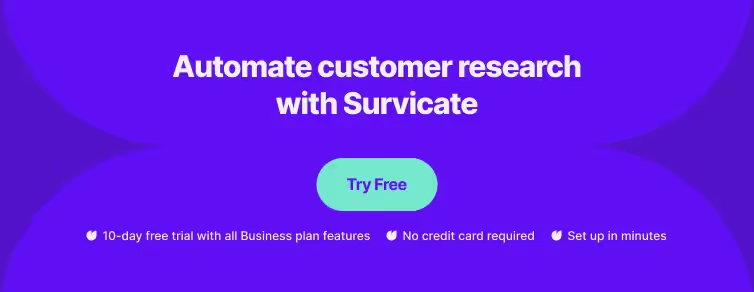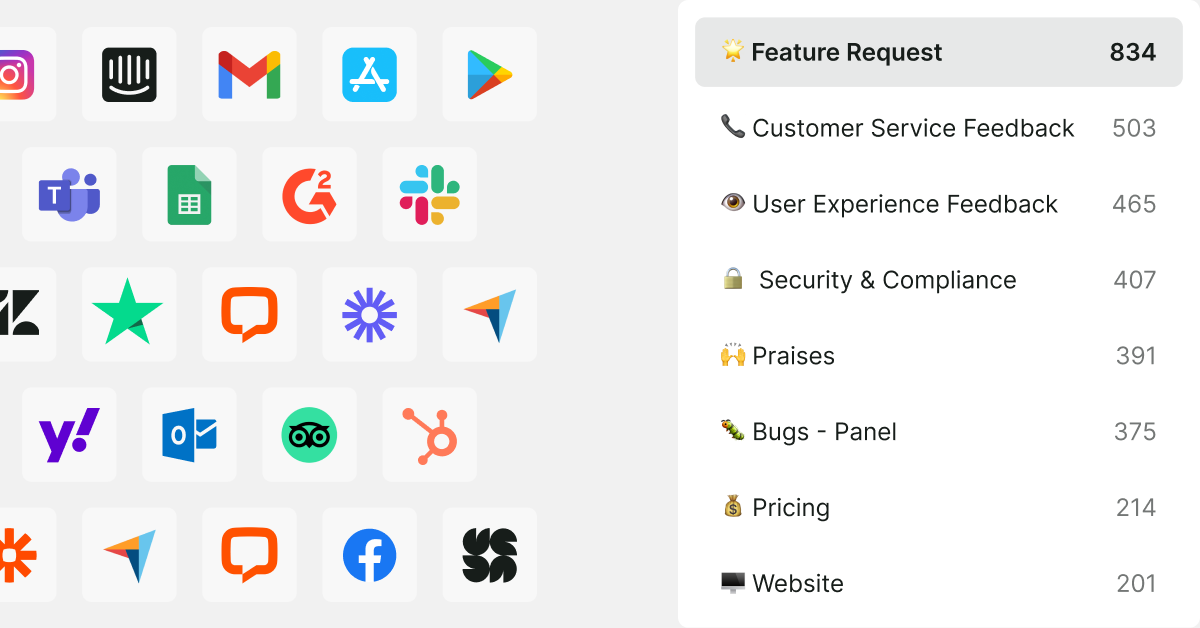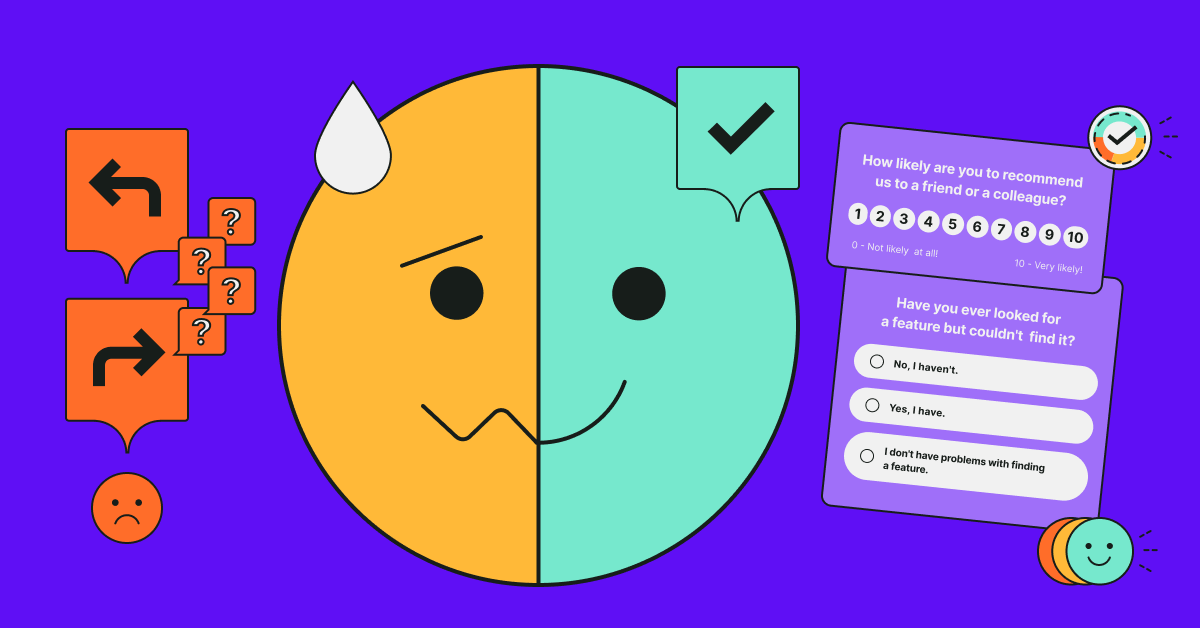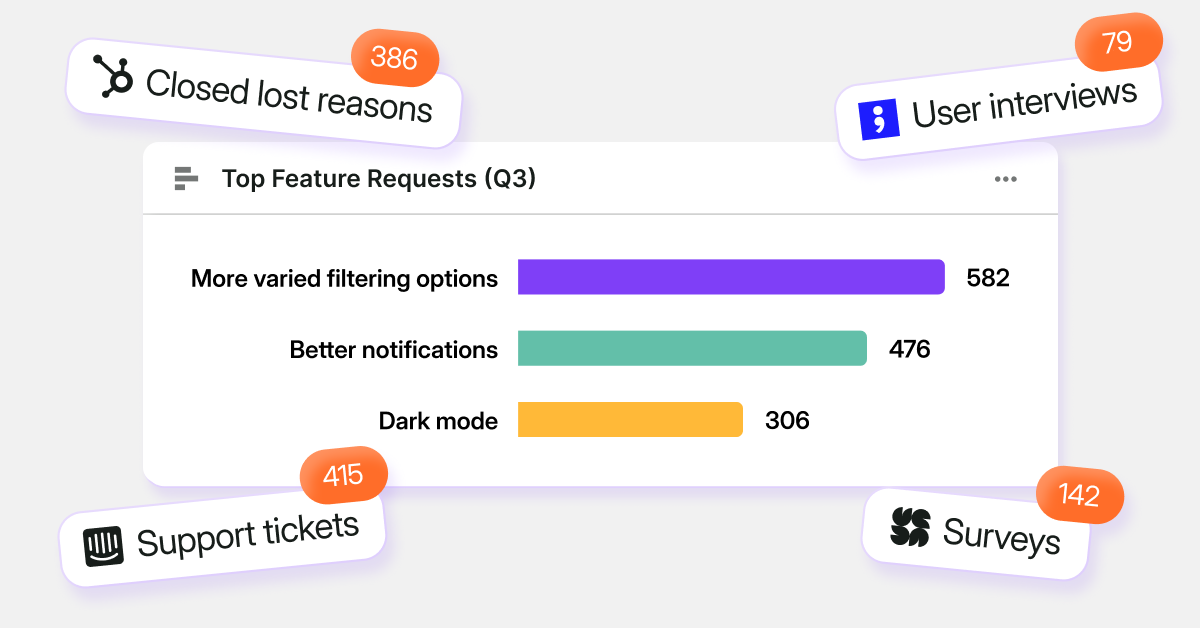tl;dr
- Start customer segmentation analysis by dividing customer data into groups with demographic questions, behavioral analytics, or previous interactions for targeted marketing.
- Utilize customer segmentation to enhance marketing efforts, guide product development, and improve customer retention and loyalty.
- Segment customers with criteria such as demographic factors, geographic location, psychographic elements, and behavioral characteristics for effective segmentation.
- Segment customers with tools like Data Management Systems, CRM, Customer Experience Management software, Marketing Automation and Market Segmentation tools for insightful data collection and targeted communication.
- Measure the success of customer segmentation by tracking customer experience KPIs, Customer Lifetime Value, and retention rates to refine and improve strategies.
- Customer segmentation analysis is a powerful tool you can leverage to tailor your marketing strategy effectively.
By recognizing and categorizing the unique characteristics of your customer base, you can tailor your approach to meet their specific needs. If your business addresses offers to a broader customer group, creating resonating messaging for everyone might not be so obvious.
To make your efforts more effective, try out customer segmentation analysis – recognize different customer groups based on their preferences and behavior to optimize your messaging, campaigns and offers.
Learn how to group customers and increase customer loyalty, and satisfaction to steer your business towards profitability and sustainability.

Understanding Customer Segmentation
Customer segmentation analysis allows you to categorize your customer base into distinct groups based on specific criteria, leading to targeted marketing and better customer service.
Customer Segments Importance
Defining customer segments is central to understanding the diverse needs and behaviors of your customer base. By identifying key segments, you can tailor your approach to meet the distinct needs of each group.
For instance, value-based customer segmentation focuses on the potential lifetime value of customers, enabling you to allocate resources effectively and foster long-term relationships with the most valuable customers.
- Identifying high-value customers can lead to optimized resource allocation.
- Customer segmentation highlights customer needs, guiding product development.
Benefits of Customer Segmentation
Customer segmentation analysis yields multiple benefits:
- Enhanced Marketing Efforts: By understanding your customer segments, your marketing strategies can be highly tailored, improving campaign effectiveness and ROI.
- Product Development: Insights from customer segmentation inform the creation of products that specifically meet the needs of different customer groups.
- Customer Retention: Knowing your segments allows for customized experiences that can increase loyalty and reduce churn.
- Strategic Decision-Making: Data-driven customer segmentation analysis informs strategic choices, ensuring they reflect the behaviors and preferences of your customer segments.
Each benefit directly impacts your business's bottom line, creating a more customer-centric, efficient, and ultimately successful operation.
Customer Segmentation Criteria
By categorizing users based on distinct attributes, companies can design more effective marketing campaigns, develop targeted products, and enhance customer service.
The main criteria for customer segmentation include demographic factors, geographic considerations, psychographic elements, and behavioral characteristics. Understanding each segment in detail can help a company to better meet the needs of its customers and improve its market position.
Demographic Factors in Customer Segmentation
Demographic customer segmentation is the process of dividing the market into groups based on variables such as age, gender, income, education level, and marital status.
These factors are easily measurable and provide a quick snapshot of the customer's likely needs and wants.
- Age: By understanding the age range of their customers, companies can create products and marketing messages that resonate with the particular life stage of each age group. For instance, a tech company might target younger consumers with cutting-edge gadgets, while a healthcare provider might focus on older adults with products for aging well.
- Gender: Products and marketing strategies can be designed to appeal to men, women, or non-binary individuals by acknowledging the different preferences and expectations each group might have. Apparel companies, for example, often have distinct product lines for different genders
- Marital Status: The needs of single individuals, married couples, or those who are divorced or widowed can vary significantly. A travel agency might offer adventure tours for singles and romantic getaways for couples.
Demographic data can often be gathered from customer profiles, microsurveys, and purchasing records, providing a foundation for targeted marketing and product development.
Geographic Considerations in Customer Segmentation
Geographic segmentation involves categorizing customers based on their physical location, ranging from broad regions to specific neighborhoods. T
his customer segmentation is crucial because customer preferences and needs can vary widely based on where they live.
- Country, state, or city: Different regions have unique cultural norms, economic conditions, and legal regulations that can influence consumer behavior. A company might sell winter gear primarily in colder climates, while marketing swimwear in coastal regions
- Urban vs. rural: The distinction between urban and rural customers can impact product offerings and distribution strategies. Urban customers might have greater access to brick-and-mortar stores, while rural customers may rely more on online shopping and delivery services.
Understanding the geographic distribution of your customers allows you to align your marketing strategies and product distribution with local demand patterns.
Geographic data can be collected through sales data analysis or customer address information collected during previous orders.
Psychographic Elements in Customer Segmentation
Psychographic customer segmentation delves deeper into the qualitative aspects of consumer profiles by analyzing their psychological attributes. This includes their values, attitudes, interests, and lifestyles.
Unlike demographic and geographic data, psychographic information is not as straightforward to gather, but it provides a richer understanding of what drives customers' decisions and preferences.
- Interests: By identifying what hobbies or activities existing customers are passionate about, companies can create products and messages that align with those interests. For example, a company that sells outdoor gear may target individuals interested in hiking, camping, or rock climbing. This can be identified through surveys, social media activity, and purchase history related to those interests.
- Lifestyle: This can range from being health-conscious, which might involve a focus on organic foods and fitness, to a commitment to sustainability, which might include purchasing eco-friendly products. A lifestyle-oriented customer segmentation allows companies to appeal to the values and routines that define their customers' day-to-day lives. Tracking the types of products customers buy, the services they use, and the content they engage with on social media can provide insights into their lifestyle choices.
- Personality Traits: Understanding whether your customers are more introverted or extroverted, adventurous or cautious, can affect how they perceive your products and marketing efforts. An adventure travel company might target bold and adventurous personalities with high-energy, risk-taking travel packages.
Social listening tools and AI-driven analytics can help parse through large datasets to identify trends and patterns related to psychographic characteristics.
By leveraging this data, companies can craft nuanced marketing strategies that speak directly to the hearts and minds of their target segments, leading to stronger customer engagement and loyalty.
Behavioral Characteristics in Customer Segmentation
Behavioral customer segmentation is a powerful approach that focuses on how customers act, specifically regarding their purchasing patterns and their engagement with a brand. This type of customer segmentation offers actionable insights that can drive personalized marketing strategies, enhance customer experiences, and improve product development.
- Purchasing habits: By examining the purchasing behavior of customers, companies can identify various buyer profiles, such as those who make purchases regularly versus those who buy only during certain occasions or sales events.
- Brand interactions: Understanding how customers interact with a brand across various channels can reveal their preferences and the effectiveness of the company's communication strategies. This is valuable insight to power up your brand marketing strategy.
- Usage Rates: Segmenting customers based on how frequently or intensively they use a product can inform companies about different user needs and potential upsell opportunities. Heavy users may benefit from premium offerings or additional features, while light users might need more engagement to increase their usage.
Behavioral data can be gathered through various means, including monitoring online behavior with cookies and tracking pixels, analyzing point-of-sale systems, and directly asking customers for feedback.
By leveraging this data, companies can predict future buying behaviors, personalize marketing efforts, create targeted promotions, and identify the most loyal and profitable customer segments.
Customer Segmentation Models and Methods
In the customer segmentation process, your focus is on understanding the distinct groups within your market. The methods and models specified here are designed to decipher patterns and behaviors, helping tailor your strategies to effectively meet your customers’ needs.
Customer segmentation models overview
Customer segmentation models are frameworks that businesses use to categorize their consumer base into distinct groups with similar characteristics, behaviors, or needs.
These models enable companies to target specific segments with tailored marketing strategies, product offerings, and services, thus enhancing customer satisfaction and loyalty while optimizing resource allocation.
By combining demographic, geographic, psychographic and behavioral models, businesses can develop a multi-dimensional view of their market, allowing for highly personalized and effective marketing campaigns. Advanced analytics and data collection methods, such as AI and machine learning, are increasingly used to refine these models and provide dynamic, real-time customer segmentation.
Le's dive into the specific methods of customer segmentation. This will let you to understand how you can effectively create customer segments.
Cluster Analysis
Cluster Analysis allows you to group the customer data based on similar characteristics. You often use a customer segmentation model within this method, which typically involves:
- Identifying variables relevant to your business, such as age, income, or buying habits.
- Applying statistical techniques, like k-means clustering, to segment customers into distinct groups.
The goal is to create clusters of customers with similar traits so that you can effectively target relevant segments in your campaigns.
Behavior Patterns
Analyzing behavior patterns involves examining the actions your customers take. This includes:
- Purchase frequency
- Average order value
- Customer loyalty and retention rates
Understanding these patterns enables you to predict future behaviors and tailor your marketing efforts to get more potential customers.
Predictive Analytics
Predictive Analytics takes your customer segmentation models to the next level. It involves:
- Using historical data to forecast future trends.
- Creating predictive models using machine learning to identify potential opportunities or risks.
This analysis informs you about the likely future behaviors of different customer segments, empowering you to make data-driven decisions.
Implementing Customer Segmentation Analysis
When you implement a customer segmentation analysis strategy, you focus on identifying specific market subsets, tailoring your marketing efforts to these segments, and aligning them closely with sales strategies to drive revenue effectively.
Segment Identification
Your first step is to define the segments within your market clearly. This involves an analysis of demographic, psychographic, and behavioral data to group customers with similar characteristics. By establishing a clear customer segmentation strategy, you increase the precision of your marketing campaigns.
Target Audience Profiling
Once you have identified your segments, the next step is to create in-depth profiles for each market segment. This detailed profiling informs tailored marketing messages that resonate on a more personal level, improving engagement and conversion rates.
- Individual Segment Profiles:some text
- Segment A: Young professionals, tech-savvy, high disposable income.
- Segment B: Middle-aged homeowners, value-oriented, family-focused.
Marketing and Sales Alignment
For maximum impact, your marketing and sales approach must be synchronized. Integrating your customer segmentation strategy across both departments ensures that marketing efforts support sales goals, leading to a coherent customer journey from awareness to purchase.
- Alignment Strategies:some text
- Shared goals and KPIs.
- Constant communication channels between departments.
- Joint training sessions to understand customer profiles.
Tools for Customer Segmentation Analysis
Effective customer segmentation analysis relies on the adept use of specialized tools designed to gather, manage, and interpret customer data. These tools allow you to pinpoint customer groups based on various criteria including behavior, demographics, and technographics.
Data Management Systems
Your capability to segment customers effectively begins with the foundation of robust Data Management Systems. These systems enable you to collect and consolidate customer data from various sources, ensuring it's clean and organized.
A powerful data management platform helps you to precisely analyze existing customers based on their technology usage, like tracking which devices they prefer or what software they rely on in their daily tasks.
CRM Integration
Customer Relationship Management (CRM) tools are pivotal for storing and analyzing customer interactions. With CRM integration, you deepen your understanding of each customer's journey.
By combining technographic segmentation with behavioral data from your CRM tool, you can craft more tailored communications. For instance, you might identify customers who frequently use mobile apps and then target them with app-specific promotions or updates.
Marketing Automation
Marketing Automation software takes customer segmentation to the next level. Not only can you automate engagement with segmented groups, but you can also track responses and adapt campaigns in real time.
Imagine sending out a campaign to users of a specific device and then using marketing automation to fine-tune the campaign based on immediate results.

Customer Segments in Marketing Communication
Understanding customer segments is crucial for tailoring your marketing communication to meet the diverse needs and preferences of your target audience.
Messaging and Positioning
Messaging forms the core of how you communicate your brand's value proposition to different customer segments. It is vital to personalize your message to resonate with each segment's specific characteristics and buying motives.
For example, if you're targeting a tech-savvy audience, your messaging should emphasize cutting-edge features and innovation.
Positioning your product or service in the mind of each customer segment is equally critical. You want each message to reinforce the perception that your offerings are the perfect fit for that particular segment.
Multichannel Approach
A multichannel approach in marketing efforts ensures that you are reaching out to your customer segments where they are most active. For instance:
- Young adults: Social media platforms, mobile apps
- Professionals: Email, LinkedIn
- Seniors: Traditional media, such as TV and newspapers
By using a combination of digital and traditional channels, you can effectively communicate and engage with each segment using the most suitable medium.
Customer Engagement Techniques
Effective customer engagement requires techniques that foster interaction and encourage customers to become more involved with your brand.
- Feedback and Surveys: Provide direct channels for customers to voice their needs and opinions.
- Exclusive Events or Offers: Create special promotions tailored to each segment's interests and behaviors.
- Community Building: Use social media or forums to build a community around your brand, catering to the specific topics and discussions relevant to each segment.
Remember, consistent engagement can result in a more loyal customer base and build long-term relationships with each segment.
Customer Experience optimized for all Customer Segments
To effectively cater to diverse customer needs, you must refine each segment's experience based on available data.
Customer Journey Mapping
Understanding the customer journey is crucial for each segment you serve. Using a Customer Journey Map, identify touchpoints where customers interact with your brand and monitor their experiences. This will allow for a tailored approach that meets specific needs and preferences. For instance:
- Awareness Stage: Ensure your marketing channels resonate with the segment's interests.
- Consideration Stage: Offer tailored information to guide decisions.
- Purchase Stage: Streamline the process for ease and convenience.
- Post-Purchase: Provide segment-specific support and follow-up.
Service and Product Customization
Customizing your service and products is effective in addressing the unique demands of each segment. Here's how to integrate this into your strategy:
Product Development: Develop and adjust products to fit the segment's specific use cases or preferences.
Customer Service: Train your support team to recognize and respond to the requirements of particular segments. For instance:
- B2B Clients: Might require a more formal tone and detailed technical support.
- Younger Consumers: Often prefer faster, more casual interactions perhaps through social media channels.
Feedback and Iteration
Regularly gathering and acting on customer feedback is pivotal for continuous improvement. Implement a process to:
Collect Feedback: Use surveys or direct engagement to gather insights. Act on Feedback: Adapt and iterate your offerings based on the received feedback.
Tracking Changes: Maintain logs of updates to services or products, noting how they're influenced by customer insights. This can include:
- Adding features requested by a major segment.
- Enhancing user interfaces to be more accessible for a particular group.
By meticulously crafting the customer journey, personalizing services and products, and harnessing feedback for iterative improvements, your customer experience strategy will be well-suited to satisfy the diverse spectrum of your customer base.
Metrics and Performance of Customer Segmentation Analysis
Proper metrics and performance evaluation are crucial for understanding the efficacy of customer segmentation analysis. Your ability to measure results accurately will greatly inform your decisions and strategies going forward.
Key Performance Indicators
Key Performance Indicators (KPIs) are crucial in evaluating the success of customer segmentation.
You'll want to monitor segmentation depth, which is the percentage of your total customer base that falls into your defined segments, and customer segmentation accuracy, which measures how closely customers in a segment match the defined segment criteria.
Tracking the conversion rate within each segment can also tell you how well-targeted your marketing strategies are.
Customer Lifetime Value
Customer Lifetime Value (CLV) quantifies the total value a customer is expected to contribute to your business over the entirety of your relationship.
Accurately calculating CLV can help you understand where to allocate resources to maximize profits. When paired with customer segmentation, CLV can reveal which segments are most valuable and warrant additional investment.
Retention and Loyalty Tracking
Effective customer segmentation can improve customer retention and brand loyalty.
By measuring the retention rate of each segment, you gain insights into which segments are more loyal and likely to make repeat purchases.
Tools like the Net Promoter Score (NPS) are instrumental in gauging loyalty by asking customers how likely they are to recommend your brand to others.
It's essential to continually refine your approach based on these metrics to strengthen customer relationships and optimize the overall performance of your customer segmentation efforts.
Wrapping up
Customer segmentation analysis is essential for understanding and catering to the diverse needs of your customer base. By dividing customers based on demographic, geographic, psychographic, and behavioral factors, businesses can tailor marketing efforts, improve products, and enhance customer retention effectively.
Utilizing tools like CRM systems, marketing automation, and constant evaluation through metrics like Customer Lifetime Value and retention rates enables precise targeting and improved business outcomes. Embracing customer segmentation leads to more personalized customer experiences, stronger loyalty, and increased profitability, making it a critical strategy for sustained business growth.
Using surveys in customer segmentation allows for direct feedback from different user segments, ensuring your strategies are accurately aligned with their needs. Ready to try this today? Our free Business trial is waiting for you – sign up today!














.svg)

.svg)



